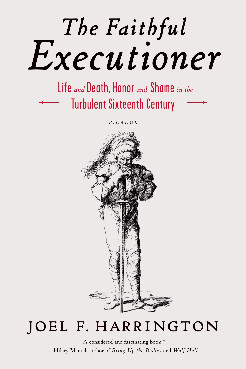Neighbors in Bamberg had become accustomed to the weekly ritual getting under way in the back courtyard of Meister Heinrich Schmidt’s house and went about their business uninterested.
Most of them were on cordial terms with Schmidt, the prince-bishop’s new executioner, but remained wary of inviting him or any of his family members into their homes. His son, Frantz, the focus of his father’s attention on this May day in 1573, appeared to be a polite and—if one could say this of the offspring of a hangman—well-bred youth of nineteen. Like many teenagers of the day, he planned to follow his father into the same craft, a path he began as early as the age of eleven or twelve. Frantz’s childhood and adolescence had been spent in his native Hof, a small provincial town in the far northeast corner of modern-day Bavaria, ten miles from what is now the Czech border. Since the family’s move to Bamberg eight months earlier, he had already accompanied Heinrich to several executions in the city and nearby villages, studying his father’s techniques and assisting in minor ways. As he grew in size and maturity, his responsibilities and skills developed apace. Ultimately he intended to become, like his father, a master in the practice of “special interrogation” (i.e., torture) and in the art of efficiently dispatching a condemned soul in the manner prescribed by law, using methods that ranged from the common execution with the rope, to the less frequent death by fire or by drowning, to the infamous and exceptionally rare drawing and quartering.
Today Meister Heinrich was testing Frantz on the most difficult—and most honorable—of all forms of execution, death by the sword, or beheading. Only during the past year had father considered son capable and worthy of wielding his cherished “judgment sword,” an engraved and elegantly crafted seven-pound weapon that spent most of its time hanging in an honored spot over their fireplace. They’d begun their practice months earlier with pumpkins and gourds before moving on to sinewy rhubarb stalks, which better simulated the consistency of the human neck. Frantz’s first attempts were predictably clumsy and at times endangered himself and his father, who held the poor sinner firmly in place. Over the weeks, his gestures gradually became more fluid and his aim more accurate, at which point Meister Heinrich deemed his son ready to ascend to the next level, practicing on goats, pigs, and other “senseless” livestock.
Today, at Schmidt’s request, the local “dog slayer,” or knacker, had assembled a few stray canines and brought them in his ramshackle wooden cages to the executioner’s residence in the heart of the city. Schmidt paid his subordinate a small tip for the favor and removed the animals to the enclosed courtyard behind the house, where his son was waiting. Though there was only an audience of one, Frantz was visibly anxious. Pumpkins, after all, did not move, and even pigs offered little resistance. Perhaps he felt a twinge of apprehension about killing “innocent” domestic animals, though this is likely an anachronistic projection. Above all, Frantz knew that successful decapitation of the former pets before him, each requiring one steady stroke, would be the final step in his apprenticeship, a visible sign of his father’s approval and of his own readiness to go out into the wider world as a journeyman executioner. Meister Heinrich again played the part of the assistant and held the first yapping dog fast while Frantz tightened his grip on the sword.
